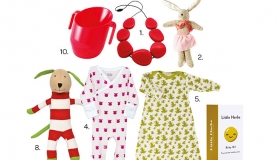Sleeping in close proximity to our offspring is an ancient practice that is still common in many parts of the world. In fact, most parents bed-share or co-sleep with their infants, at least part of the time. Mammals also naturally sleep next to their young. It is a relatively recent Western cultural phenomenon to train babies to sleep alone, often in a separate room from their parents.
The Japanese character “kawa”, representing a river flowing between two banks, is a beautiful analogy for the practice of bed-sharing. The two banks are the parents, sleeping either side of their child, who is the river. I like to think of my husband and I as the banks supporting our son Ewan, flowing like a river between us. He will find his own way in life, free to move as he wishes, steered but not contained by the protective banks of his parents. Bed-sharing, breastfeeding and baby-wearing form the bedrocks of the continuum-style parenting philosophy we practice.
OUR STORY
In hospital, like most newborns, Ewan was placed in a separate cot beside my bed. I accepted this standard “rooming in” policy without question. Back home, I dutifully followed official advice, placing Ewan next to my bed in a Moses basket. Hourly, night after night, I propped myself up in bed and fed my hungry son, bleary eyed and exhausted. Eventually I learnt to breastfeed lying down. This was a lifesaver! The wonderful sleep inducing hormone present in breast-milk, melatonin, helped us to drift contentedly off to sleep. Bed-sharing naturally progressed from there. I long ago gave up expecting Ewan, 18 months, to sleep through the night. This is an unrealistic cultural expectation which is incompatible with infant sleeping patterns and their biological needs. Human breast-milk is low in protein and fat but high in sugar (lactose). Babies therefore need to suckle frequently throughout the day and night.
Bed-sharing can form an essential, valuable component of working parents’ busy lives. It enables couples to reconnect with their child after periods of separation. My husband works away from home in the week, so bed-sharing is a wonderful opportunity for father and son to bond. Sharing night-times with our son is really magical, especially in these precious early years, which are so fleeting. Waking to beaming smiles, warm soft skin and cuddles from Ewan is irreplaceable.
As Ewan grows I trust he will communicate his need to move into his own bed, when the time is right. This is in much the same way that I know he will wean from the breast, when he is emotionally and physically ready.
BED-SHARING AND BREASTFEEDING
The primary reason I started to bed-share was because I nurse my son. Bed-sharing makes breastfeeding more convenient, ensuring we both get a good night’s sleep. One of the most commonly cited reasons for the short duration of breastfeeding in the UK is low milk supply. Bed-sharing enables babies’ unrestricted access to the breast throughout the night. Frequent suckling releases the hormone prolactin, which stimulates more milk production. Because prolactin is released in greater quantities during night-time feeds, suckling at night is essential in maintaining milk supply. Breastfeeding can become a more positive experience because mother and child are calmer and more refreshed.
SAFE BED-SHARING
Bed-sharing is a lost art, no longer second nature because over the past two centuries we have stopped practicing it. We therefore need accessible, user-friendly information about how to bed-share safely. However, restrictive NHS policies mean health professionals cannot advise parents about how to bed-share. The media has also played its part in scaremongering the public by presenting an oversimplified picture of the risks of bed-sharing, without considering evidence-based research demonstrating its merits. One new mum whispered to me recently, ‘we know we shouldn’t, but we bed-share with Lucy,’ as if revealing a dark secret.
Helen Ball, leading infant and child sleep researcher based at Durham University, provides a succinct account of how to bed-share safely. You must consider who is bed-sharing, under what circumstances (where and how) and the way it is conducted (what). For instance, if you or your partner smoke or take drugs it is unsafe to bed-share. Babies can become trapped between bed-frames and the wall, or smothered in bed-sheets. James McKenna’s book ‘Sleeping with Your Baby’ also contains useful, easy-to-follow safety advice, including visual do’s and don’ts.
A mother’s instinct is also significant. I am sensitive to Ewan’s every movement when he sleeps; friends of mine who bed-share report similar levels of heightened responsiveness to their babies. This is backed-up by evidence from numerous studies that suggest that breastfeeding mothers instinctively protect their babies during sleep.
CO-SLEEPING; ANOTHER OPTION
In the West we have been trained to sleep deeply and alone, so sleeping next to an infant who naturally wakes frequently can be disruptive. It can also hinder a couple’s more intimate moments together. In addition, bed-sharing is a cultural taboo. These factors mean bed-sharing does not work for many families. Co-sleeping is another viable option, which enables parents to sleep in close proximity to their child but on a separate surface. Various co-sleeping products are readily available for this purpose, including cots which slot next to the bed, hammocks and bassinets.
Co-sleeping helps promote successful breastfeeding, because mothers can respond promptly to their baby’s feeding cues. The government also recommends co-sleeping for the first six months of a child’s life, whether the child is breast or formula fed. Research indicates this can help reduce the incidence of sudden infant death syndrome (SIDS). Parents feel at ease hearing their baby’s steady breathing close by and can quickly respond to any concerns. Co-sleeping has the added benefit of providing couples with the personal space valued so highly in the West.
CULTURAL NORMS
Bed-sharing is a contentious, emotive topic. We are influenced by the commonly held view that bed-sharing is a sign of ‘giving in’ or spoiling our children. As a society we separate our children from ourselves by weaning them early. We use a plethora of equipment to aid this separation, including cots, pushchairs and bottles. This is not a conscious choice; we have been culturally conditioned into acting in this way without questioning why or considering the alternatives.
Training infants to sleep through the night in their own room is often a battle fraught with difficulty and emotion. Leading childcare ‘experts’ promote techniques, such as ‘crying it out’ and ‘self-soothing’, which they guarantee will enable children to sleep soundly and alone. Children are taught to rely on transitional objects for emotional security, such as dummies and comforters, instead of the natural protectiveness of another human being. It is worth questioning why we value materials over the comfort of each other.
In Asian countries, values such as family closeness and interdependence mean bed-sharing up to pre-school age is common and socially acceptable. Western cultures emphasise independence, self-sufficiency and competitiveness, which appear to be incompatible with attachment-style parenting practices. However, broadly-speaking, the more emotionally secure a child’s background, the more confident and therefore independent they will be as adults. For instance, in Why Love Matters, Sue Gerhardt explains the significance of early affection in shaping babies’ brains. She demonstrates how parents’ unresponsiveness to their babies, such as leaving babies alone to cry, can have long-term negative effects on their emotional health.
“Bed-sharing is a lost art, no longer second nature because over the past two centuries we have stopped practicing it”
MODERN LUXURIES
When a child is ill or upset we routinely bring them into the parental bed. We do this to help settle our children at a time of need. In more primitive times sharing our beds with the most vulnerable members of society ensured survival. It is only with the advent of modern technologies, central heating and larger living spaces that it has been physically possible to create separate sleeping spaces for our young. Material conditions have dramatically altered in recent decades. However, babies’ physiological needs have not. As Helen Ball demonstrates, in the first months of life infants rely on the closeness and touch of their caregivers in order to regulate their breathing and temperature. A beautiful nursery, a jazzy electric rocker or the recorded sounds of a mother’s heartbeat will consistently fail to match the warmth of a caregiver’s body. If a baby was presented with this choice, which would they choose?
THE FUTURE
Bed-sharing has a growing place in our society as more parents wake up to the benefits of attachment-style parenting but we still have a long way to go. Every new parent has a right to be presented with balanced information about child sleep options, including key points from research about breastfeeding and SIDS. This is essential so that they can make fully informed childcare decisions. This will mean parents are not denied what can be one of the most natural and wonderful experiences of parenting.
WHAT TO READ:
MORE INFO
- Baby Wisdom: The World’s Best-Kept Secrets For The First Year Of Parenting Deborah Jackson
- Three in a Bed: The Benefits of Sleeping with Your Baby Deborah Jackson
- Sleeping with Your Baby: A Parent’s Guide to Cosleeping James J McKenna
- Why Love Matters: How Affection Shapes A Baby’s Brain Sue Gerhardt
Parent Infant Sleep Lab, including bed-sharing and co-sleeping research conducted by Professor Helen Ball “dur.ac.uk/sleep.lab”:http://www.dur.ac.uk/sleep.lab
Caroline is a stay-at-home mum to Ewan James. She writes at stoneageparenting.com and supports breastfeeding mums



1_278_160_c1.png)



